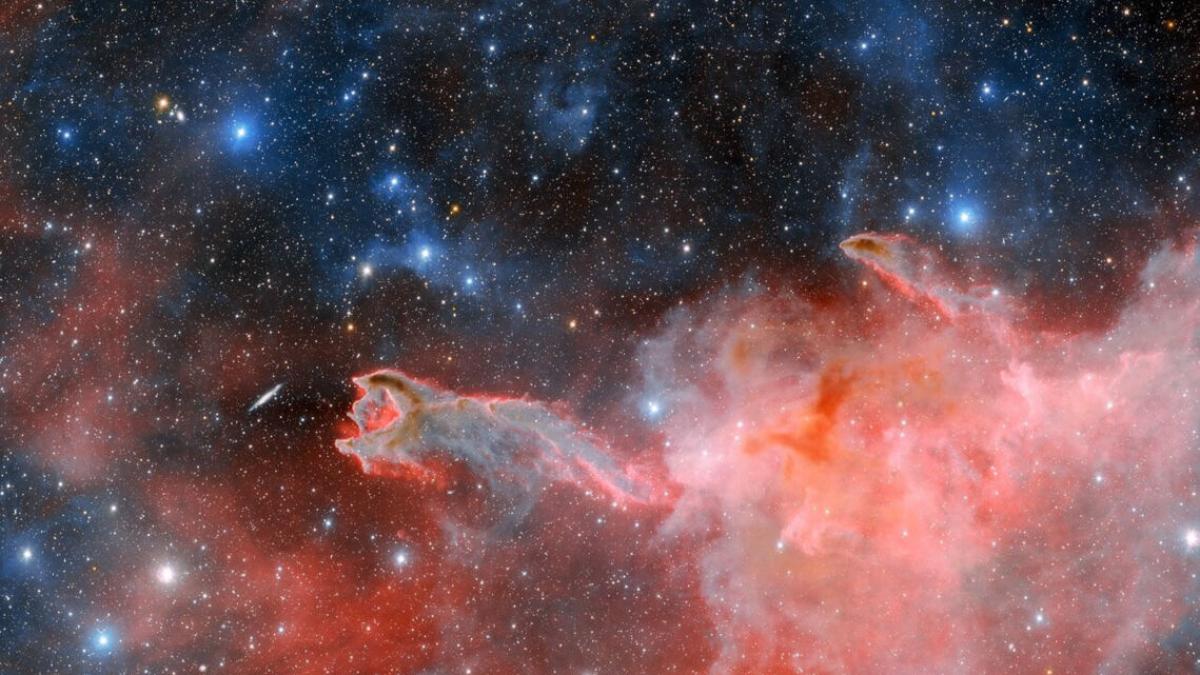About 1,300 light-years away, in the constellation Puppis, a ghostly hand emerges from the interstellar medium and reaches out into the universe.
The image was acquired by the Dark Energy Camera at Cerro Tololo Observatory in Chile, a NOIRLab program.
According to NASA, this is the comet cluster known by the abbreviation CG 4, a cloudy and ominous structure also known as the “Hand of God”, one of the many comet clusters found in the Milky Way. The distinctive shape and composition of these objects remains the subject of debate among astronomers.
Comet globules are a subclass of dark nebulae known as Bock’s globules, which are isolated clouds of dense cosmic gas and dust, surrounded by extremely hot ionized material.
When material separates from these clouds, creating a tail extending across space, they are known as cometary globules because of their vague resemblance to a comet, even though they have nothing in common.
The characteristics that classify CG 4 as a comet ball do not go unnoticed in this image taken with the Dark Energy Camera (DECam), made by the Department of Energy and mounted on the Cerro Tololo Observatory’s (CTIO) 4-meter Víctor M. Blanco telescope. . ,NSF NOIRLab Program. Its dusty head, 1.5 light-years in diameter, and its long, smooth tail, about eight light-years in length, make CG 4 a small Pocket ball, a general feature of cometary globules.
Although these objects were first observed in 1976 through images obtained using the British Schmidt Telescope in Australia, for a long time cometary globules were not discovered by astronomers because they are very faint objects. Their tails, covered in dark stardust, block most light from passing through.
However, DECam can currently, using a hydrogen alpha filter, capture the faint red glow of ionized hydrogen at the tip of CG 4 and around its outer edge.
This light is produced when hydrogen is excited after being exposed to radiation from hot, nearby massive stars.
However, the intense radiation from these nearby massive stars gradually destroys the globule’s tip and washes away small particles that scatter starlight.
However, CG 4’s dusty cloud contains enough gas to fuel the active formation of many new Sun-sized stars.
While astronomers have observed these structures throughout the Milky Way, most of them, including CG 4, are located within a huge bubble of glowing gas called the Gum Nebula, which contains at least 31 cometary globules in addition to CG 4.
It is believed that this nebula is nothing more than the expanding remnants of a supernova that occurred approximately one million years ago.
The mechanism by which these comet-like objects gain their distinctive shape is not well understood, but astronomers have at least two main ideas about their origins.
The first is that, initially, they would have been consistent with spherical nebulae, such as the Ring Nebula, which were later affected by a nearby supernova explosion, perhaps the original explosion that created the Gum Nebula.
The second idea suggests that cometary globules form through a combination of stellar winds and radiation pressure from hot, nearby massive stars.
In fact, all cometary globules within the Gum Nebula appear to have tails extending away from the center of the nebula, where the remnants of the Saila supernova and the Saila pulsar are located.
The latter consists of a rapidly rotating neutron star formed after the collapse of a massive star, and its stellar winds and radiation pressure may have formed nearby globules.
This image also gives the impression that CG 4 is about to devour the spiral-edge galaxy ESO 257-19 (PGC 21338), which appears directly in front of it.
But in reality, the galaxy is more than a hundred million light-years away from CG 4 and appears to be close only through a chance alignment.

“Proud web fanatic. Subtly charming twitter geek. Reader. Internet trailblazer. Music buff.”

:quality(85)/cloudfront-us-east-1.images.arcpublishing.com/infobae/TEQF6EONZRFGLLLDIDD4L2O4EE.jpg)

:quality(75)/cloudfront-us-east-1.images.arcpublishing.com/elcomercio/XU32LRAEZFDDPNVHLFU3CKVBYY.jpg)



More Stories
How to create 3D videos with my iPhone, it will be very useful even for your business
NASA discovers an anomaly in the Earth’s magnetic field that could have serious consequences for humans
Can the Earth be divided into two parts?